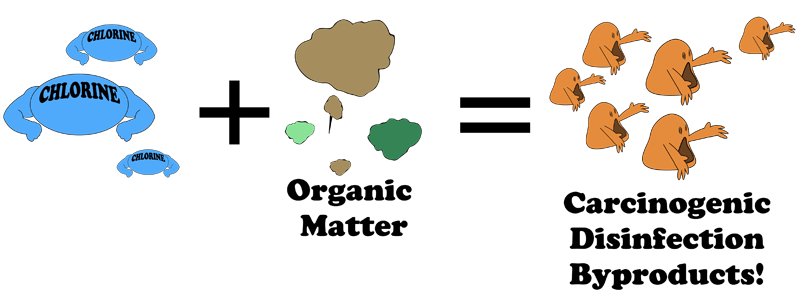TV News alleges:
In 2013 and 2014, Sacramento residents were exposed to a carcinogenic chemical in their drinking water called aluminum chlorohydrate.
During those 2 years, Sacramento tested aluminum chlorohydrate (ACH) at its main water treatment plant and according to TV station ABC10, alarm bells sounded almost immediately.
But… the city didn’t warn locals or take action for a year.
 It appears Sacramento residents were exposed to disinfection byproducts (DBP: considered likely carcinogens). They have already been linked to an increased risk of bladder cancer. DBPs are typically found in products like deodorants, body washes and soaps. In addition to being potential cancer-causers, they’ve been shown to disrupt hormones and congest the lymph system when absorbed through the skin. These byproducts have also been known to cause low birth rate and even miscarriages.
It appears Sacramento residents were exposed to disinfection byproducts (DBP: considered likely carcinogens). They have already been linked to an increased risk of bladder cancer. DBPs are typically found in products like deodorants, body washes and soaps. In addition to being potential cancer-causers, they’ve been shown to disrupt hormones and congest the lymph system when absorbed through the skin. These byproducts have also been known to cause low birth rate and even miscarriages.
Even though the testing generated DBPs at levels considered unsafe by the U.S. Environmental Protection Agency (EPA), especially with long-term use, it seems the city of Sacramento allowed the testing to continue. Sacramento’s Utility Director, Bill Busath says that the testing of ACH to replace another water treatment chemical called ALUM was intended to be a short-term trial, but continued for a full year because of the almighty dollar.
“There was an expectation that we would be able to save quite a bit of money,” he told ABC10.
Sacramento officials have finally admitted that the test created a dangerous situation, saying it allowed DBP numbers to rise to “historically high levels when using (ACH) aluminum chlorohydrate.”
ACH and ALUM are used to take river water and bond with impurities after they enter a treatment plant, but the ACH proved ineffective. To cope with the problem, city officials pumped in more chlorine, which bonded with the organic compounds, turning the chlorine into DBPs.
Busath said, “As soon as the levels got to where we thought that we wouldn’t be in compliance, and hence wouldn’t be protective of public health, we stopped the trial.”
But the trial didn’t end until May 2014, a full year after it began. Internal tests performed by the city show that time after time, the DBP readings went above what the EPA considers safe for long-term exposure. A city chemist noticed the problem three days into the test.
In an e-mail to managers, the chemist wrote: “I’m nervous about the distribution samples.”
Bob Bowcock, a man who grew up working in the water treatment industry and is an adviser to Erin Brokovich, explains that DBPs are especially dangerous for pregnant women and unborn babies.
“In first trimester pregnancies, there’s a significant rise in miscarriages, and in third trimester there’s evidence of low birth weight,” he said, describing how the water contaminated with DBPs is even more dangerous when its mists are breathed in while showering or washing dishes.
“I think the testing should have stopped immediately,” Bowcock said. “I think they should have called the Division of Drinking Water.”
But the lives of mothers and babies didn’t seem to matter to Sacramento city officials, who, it appears, ignored the warnings and, instead, expanded the test and told city council they needed enough money allocated, $850,000, to buy a truckload of ACH every week for a year for more testing.
In July 2013, Busath and other utility heads officially signed Sacramento residents up to be guinea pigs for a full year, telling the city council in a staff report that the State of California “has now mandated that the trial be extended from three weeks to a full year.”
But there is one little problem: the California EPA Division of Drinking Water claims it never told the city that it had to conduct a year-long trial of ACH or any other chemical. It was just the opposite.
“The city approached us,” said Division of Drinking Water Deputy Director Bruce Burton. “It was the city who asked us if they could use that chemical at their water treatment plant.”
When interviewed by ABC10, Busath said:
“The word mandate used in the council report was probably a poor choice of words.”
And when the news outlet asked Busath why the test continued, he repeatedly gave the same answer. “Because we had the anticipation of saving money with using ACH,” said Busath.
So, why didn’t Busath’s department share the troubling data with regulators and the public? Says Busath:
“As long as we were in compliance, we don’t need to contact them. All this trial, we were within the guidelines for the disinfectant byproduct levels, which is a one-year running average.”
At least once, in January 2014, the Sacramento River Plant where the chemicals were being tested was turned off, and the city took water from another plant on the American River. The city even intentionally switched water sources from the city to the county after one of the quarterly tests.
This was the subject of one email; “Request for emergency water service from Sacramento County Water Agency to the City of Sacramento.”
The emergency was that if Sacramento didn’t get water from another source, it was doomed to exceed yearly standards for its disinfection byproducts.
Sources:
[1] ABC10
Ian: DBP’s are a very unfortunate result of the addition of chlorine to our water supply. If our water supply carried no organic matter, chlorine would not create DBP’s. In reality, there’s always some organics in our water, and hence, some DBP’s. Luckily for our clients, the UltraStream’s powerful catalytic carbon neutralises DBP’s with ease.
